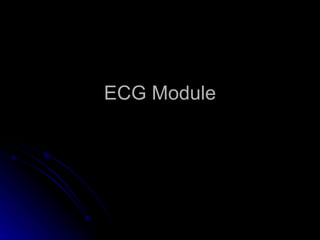Denunciar
Compartir

Recomendados
Más contenido relacionado
La actualidad más candente
La actualidad más candente (20)
ECG - Junctional Arrhythmia & Ventricular Arrhythmia

ECG - Junctional Arrhythmia & Ventricular Arrhythmia
ECG Final Proff.Sumit Kr Ghosh Dept of Internal Medicine Medical College 88 C...

ECG Final Proff.Sumit Kr Ghosh Dept of Internal Medicine Medical College 88 C...
5th part ECG basics: supraventricular arrhythmias Dr Salah Mabrouk Khallaf

5th part ECG basics: supraventricular arrhythmias Dr Salah Mabrouk Khallaf
Similar a EKG Module
Similar a EKG Module (20)
Edited_-_ECG_Interpretation_and_Arrhythmia_Recognition_-_Azeren.pptx

Edited_-_ECG_Interpretation_and_Arrhythmia_Recognition_-_Azeren.pptx
Más de callroom
Más de callroom (20)
Myocardial Viability - the STICH Trial NEJM May 2011

Myocardial Viability - the STICH Trial NEJM May 2011
EKG Module
- 1. ECG Module
- 2. The patient is an elderly man who presented to the emergency ward with dizziness Rate – 42 bpm Normal Sinus Rhythm L axis deviation PR prolongation Widened QRS Peaked T waves #16
- 4. This 10-second rhythm shows at least three different rhythms! Can you find them? Atrial Flutter Sinus Beat Atrial Fibrillation
- 7. Regular, Rate 93 bpm Normal Sinus Rhythm R atrial enlargement # 2
- 9. Regular Ventricular Rate 90 bpm Atrial Rate 180 bpm
- 10. Ventricular Rate 180 bpm
- 11. 85-year-old patient with valvular heart disease and congestive heart failure. #18 Regular, Rate 88 bpm P-wave downward in II, Not Sinus Rhythm Atrial rate – 220 with 2:1 AV block
- 13. 51-year-old female with palpitations. # 5 Regular Rate 142 bpm No clear P waves before QRS – Not sinus rhythm Retrograde P-waves, with short RP interval
- 14. Resting ECG in a 65 year-old male with complaint of palpitations. Regular Rate 150 bpm No clear P waves before QRS – Not sinus rhythm Retrograde P-waves, with short RP interval
- 15. Mechanism of Reentry An impulse initiated in the SA node passes through both the AV node and the accessory pathway A premature atrial impulse occurs and reaches the accessory pathway when it is refractory, but conduction occurs through the AV node The impulse takes sufficient time to circulate through the AV node to allow the accessory pathway to recover initiating reentry
- 16. Mechanisms of Supraventricular Tachycardia AVNRT – the AV node is divided into two pathways and the activation of the atria and ventricle is synchronous so the retrograde P-wave is buried. Account for 60% of SVT. Usu are 150-200 bpm Orthodromic AVRT – mechanism seen on previous slide. Usually, L atrium is the first site retrograde atrial activation. Accounts for 30% of SVT Widened QRS Antidromic AVRT – activation occurs in the opposite direction resulting in wide complex tachycardia that is indistinguishable from V tach
- 19. 7
- 22. RBBB Missed Beat – not sinus rhythm 12
- 24. 12
- 27. LBBB Non conducting beat 13
- 28. Atrial rate 88 bpm Ventricular rate 50 bpm
- 30. 2
- 32. 6